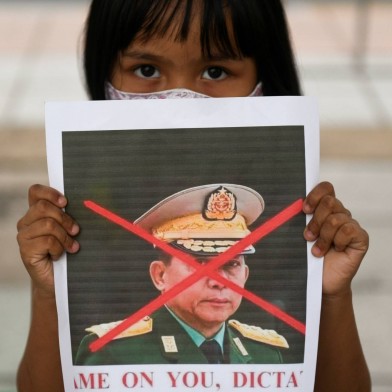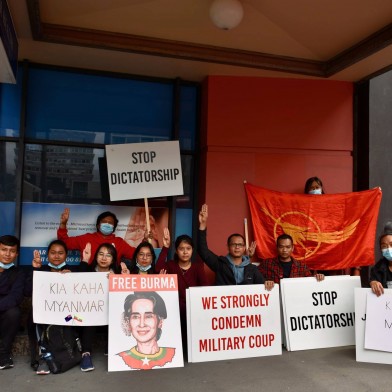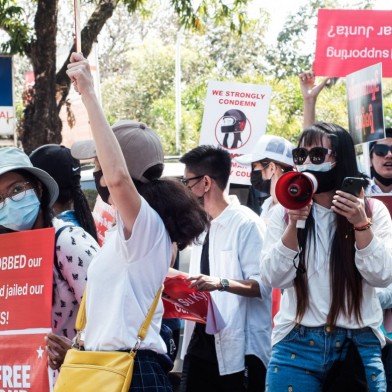The February 1 coup in Myanmar has thrown a lot of uncertainty onto the country’s future. Can a truly democratic government return or will the Tatmadaw (Myanmar military) keep hold of its role in the country’s political scene? And what effect could Myanmar’s ethnic armed organisations have in a struggle between the military and a rising resistance? Stan Jagger, consultant and researcher, answers these – and more – for the AMC.
The situation in Myanmar has intensified now to a point where an armed society-wide uprising against the army is possible. What does that mean for the future of the country and would such a popular uprising have any chance of success?
While there has been widespread resistance to the military crackdown in the cities, it is not armed to any real or effective extent. Slingshots, Molotov cocktails or swords are no match for a brutal army willing to use automatic weapons, sniper rifles and rocket-propelled grenades against civilians.
The main possibility for organised armed resistance is long-standing ethnic armed organisations (EAOs) with their own armies that control areas in ethnic border regions. The Committee Representing the Pyidaungsu Hluttaw (CRPH), acting as a shadow civilian government, has reached out to EAOs for assistance in forming a federal union army to oppose the Tatmadaw. To this end, the CRPH has released a federal charter and symbolically abolished the military-drafted 2008 Constitution.

Cadets of the Kachin Independence Army (KIA) preparing for military drills at the group's headquarters in Laiza, Kachin State, Myanmar in 2016. Image: Wikimedia Commons
If larger EAOs unified and worked with the CRPH, this would pose a serious problem for the junta. The Tatmadaw, however, is adept at dividing EAO alliances through waging war against some, while offering ‘ceasefires’ with economic incentives to others.
This has already been playing out with some significant EAOs like the KNU, Kachin Independence Organisation and the Restoration Council of Shan State all expressing guarded support for the CRPH while the military junta has raced to maintain ceasefires with others, including Myanmar’s largest EAO, the United Wa State Army. The challenge will be achieving unity between EAOs, and unity between EAOs and the CRPH.
If it did face a unified armed opposition, the Tatmadaw may act with even greater brutality against civilians.
How can democratic government return in Myanmar after this level of violence, and do you think the NLD will play a part, or be replaced by another grouping? (the CRPH for example)
If Myanmar’s military junta prevails, it may try to follow a similar path to that of previous army-led Myanmar governments. It may ban the most popular political party, the NLD, and prevent Aung San Suu Kyi from participating in politics through the criminal charges they have made against her. Then, a former general may head a political proxy party aligned with the military. Any election that gave rise to this is unlikely to be free or fair.
For a truly democratic system to be established, the military needs to leave politics. That would require a new constitution and a more decentralised federal system. This is the struggle that is playing out. Given the mass atrocities the military have committed, it seems unlikely they are willing to back down. However, the Tatmadaw has not gained full control, even in the cities, and the longer the situation continues, the more possibility there is of the military splitting and a pro-democracy faction opposing the coup emerging from within it, or an alliance of ethnic armies forcing the junta from power.
Can a political grouping that constructs a democratic agenda across ethnic lines develop in Myanmar?
In the 2020 elections, many smaller ethnic political parties merged to form one larger party, chasing the ethnic voter base. Regardless, in the November 2020 elections, the party of Aung San Suu Kyi, the National League for Democracy (NLD) still won the majority of votes in most ethnic states.

Aung San Suu Kyi
Even following the NLD’s poor track record with the peace process and ongoing conflicts in ethnic areas, many voters arguably still saw it as the best option to avoid the military proxy party, the Union Solidarity and Development Party (USDP) gaining more support. USDP MPs, if elected, would work with the constitutionally mandated 25 percent of military MPs in the Union, state and region parliaments to continue the military’s central role in politics.
With the coup and the resulting resistance, ethnic divisions have reduced in unified opposition to the coup. While short-term prospects for democratic elections are poor, the NLD, or any similar party in the future, are likely to be more cognizant of the importance of a broad, ethnically diverse support base.
The Tatmadaw has always retained control of Myanmar – can they ever be effectively removed from politics?
There are a few possible scenarios through which the Tatmadaw might withdraw. Internal factions in the Tatmadaw may emerge to oppose the coup and reduce the military’s political role. There is little sign of this, but the internal workings of the Tatmadaw are hard to gauge. The economic interests of the military elites and fear of punishment in the ranks are likely to keep most in line.
Armed resistance may also lead to splits in the Tatmadaw and a withdrawal from politics. It is too early to know if there will be coordinated resistance to the military from a unified federal army of EAOs, in alliance with the CRPH. However, plans are underway to form a federal army to conduct armed resistance to the Tatmadaw in response to the rising death toll. Protestors in urban Myanmar are fleeing to areas controlled by EAOs to seek training and arms towards this end.
The Tatmadaw may return to its claims that it will withdraw from politics when the country is ‘ready for democracy’. This claim has been made for more than six decades, including after the February 1 coup. However, it is likely that this would be under the present military-drafted 2008 constitution which guarantees the Tatmadaw’s continued role in politics.
The New Zealand govt has already declared it will not recognise the military junta, but what else could it do?
As well as not recognising the junta, the New Zealand government could formally recognise the CRPH as the representatives of the legitimate, democratically elected government. No foreign governments have taken this step, but in February, New Zealand said it did not recognise the junta. New Zealand has less to lose in recognising the CRPH, although relations with neighbouring China may be a consideration.
Support for humanitarian aid to displaced people is another way NZ could take action. Over the last decade, when many governments, UN agencies and international NGOs assumed they were engaging with a process of ‘democratic transition’ in Myanmar, they increasingly worked inside the country through government channels to reach conflict-affected populations in remote ethnic border areas.
However, there was previous international engagement in the 90s and early 2000s, with local groups providing cross-border aid into ethnic areas of southeast Myanmar from Thailand. These local organisations have made a considerable contribution, especially in health and education. They have also gained access to ethnic armed organisation-controlled areas and were often accepted by these groups.
Around 2011, based on the democratic transition thesis, international donors steadily reduced funding to these border-based aid groups. The post-military coup situation in 2021 demonstrates the importance of supporting local and established welfare providers who come from border-based and ethnic communities. International donors, including New Zealand, providing funding for humanitarian assistance in these areas, should listen closely and respond to the needs of local communities to support existing services developed through decades of resistance to the Tatmadaw.
What are the main obstacles to the CRPH and EAOs forming an effective federal union army in Myanmar to oppose the Tatmadaw?
As the resistance to military rule in Myanmar grows, the CRPH and some of Myanmar’s EAOs have been in discussions about forming a federal union army. Obstacles to achieving a united front with EAOs include a long history of divisions and sometimes open conflict between them, as well as possible distrust between the EAOs and the CRPH.
There are three main groupings of EAOs with varying positions towards the Tatmadaw. First, is a group of 10 EAOs that joined the so-called ‘Nationwide Ceasefire Agreement’ in 2015; the NCA-EAO signatories. Among the most significant in this group are the Karen National Union (KNU) and the Restoration Council of Shan State (RCSS), both of which have sizeable armies of several thousand soldiers.

UWSA soldiers stand at attention during ceremonies. Image: Wikimedia Commons
A second group of EAOs has been actively fighting with the Tatmadaw over the last decade, these include the Kachin Independence Organisation (KIO), Ta’ang National Liberation Army (TNLA), Myanmar Democratic Alliance Army (MNDAA) and the Arakan Army (AA). This group is often collectively known as the Northern Alliance (NA).
Lastly, there is Myanmar’s most powerful EAO, the 20,000-strong United Wa State Army. The UWSA occupies an area of Myanmar’s northeast border with China. It has maintained a ceasefire with the Myanmar military since 1989 but also has significant relations with China.
As in previous periods of upheaval, the Tatmadaw has sought to establish ceasefires with some EAOs, while actively fighting others. Recently, senior Tatmadaw officers met with leaders of the UWSA and the Shan State Army-North to consolidate ceasefires. Meanwhile, other EAOs, particularly the KNU and KIO, have thrown support behind resistance to the coup.
Another issue impeding a united EAO approach has been ongoing territorial disputes between them.
The NLD government from 2016 to 2021 did little to advance the peace process or address ethnic grievances. The sudden overtures to EAOs to join a new federal army with the remains of a civilian administration that has no armed forces of its own is therefore likely to be viewed with some suspicion.
Nonetheless, the CRPH’s recent federal charter, its expressions of solidarity with ethnic communities that have suffered decades of the violence now being deployed by the Tatmadaw in Myanmar’s cities, and prominent CRPH leaders with ethnic backgrounds, may all help it to consolidate a united resistance with EAOs to the junta in the coming months.
- Asia Media Centre


